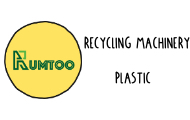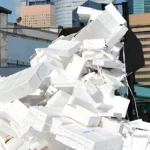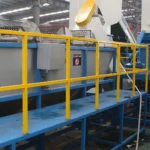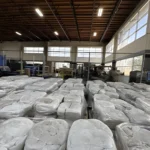What is a Plastic Recycling Machine?
Plastic recycling machines are essential tools designed to convert waste plastic materials into reusable products. These machines play a crucial role in reducing plastic pollution, conserving resources, and promoting environmental sustainability.
By processing various types of plastics, such as polyethylene (PE) and polypropylene (PP), these machines transform discarded plastic films into valuable raw materials that can be used for new production.
The functionality of a plastic recycling machine involves several stages, including shredding, washing, granulating, dewatering, drying, and pelletizing. Each stage is vital to ensuring that the final product meets quality standards and can be effectively reused.
As global awareness regarding environmental issues increases, the demand for efficient plastic recycling solutions continues to grow.
Types of Plastic Recycling Machines
There are various types of plastic recycling machines available on the market today. Each type is designed to handle specific forms of plastic waste.
For instance, some machines are optimized for rigid plastics like bottles and containers, while others focus on flexible materials such as films and bags.
Common types include:
- Shredders: These machines break down large pieces of plastic into smaller fragments.
- Granulators: They further reduce the size of shredded plastic while also cleaning it.
- Washing Lines: Designed specifically to remove contaminants from plastics before they are processed.
- Dewatering Machines: Used to remove excess water from washed plastics.
- Pelletizers: Convert clean plastic into pellets that can be easily transported and reused.
Understanding these different types allows businesses to select the right machinery based on their specific recycling needs.
Key Components of a Plastic Recycling Machine
A typical plastic recycling machine consists of several key components that work together seamlessly:
- Plastic Shredder Machine: This initial component cuts large pieces of plastic film into manageable sizes (around 1-5 inches) to prevent clogging during subsequent processing stages.
- Wet Granulator: This machine further reduces plastic size (approximately 10-20mm) while also cleaning it using water during the granulation process.
- Friction Washer: Operating at high speeds, this washer removes stubborn contaminants by allowing plastics to rub against each other.
- Sink Float Separation Tank: Utilizes water to separate lighter plastics from heavier contaminants effectively.
- Centrifugal Dewatering Machine: Removes excess water using centrifugal force before moving onto thermal drying.
- Thermal Dryer: Employs heat to remove any remaining moisture from cleaned plastics.
- Plastic Pelletizing Machine: The final step where clean plastics are turned into pellets ready for reuse.
Each component plays a significant role in ensuring that the recycling process is efficient and effective.
How Do Plastic Recycling Machines Work?
The operation of a plastic recycling machine follows a systematic process designed to maximize efficiency:
- The process begins with collecting waste plastic film which is then fed into the shredder where it gets cut down into smaller pieces.
- These smaller pieces are sent through a wet granulator where they are further reduced in size while being pre-treated with water.
- After granulation, the material enters a friction washer that cleans it by removing contaminants through friction generated by high-speed rotation.
- Next, the cleaned material goes through a sink float separation tank where lighter materials float while heavier contaminants sink and are removed.
- Following separation, excess water is removed using either centrifugal or screw press dewatering methods.
- Once dewatered, the material moves into thermal dryers where heat removes any remaining moisture content.
- Finally, clean dry plastics are processed through a pelletizer which shapes them into pellets ready for resale or further manufacturing processes.
This systematic approach ensures that each stage contributes effectively towards producing high-quality recycled materials.
Benefits of Using Plastic Recycling Machines
Investing in plastic recycling machines offers numerous advantages:
- Environmental Impact: Reduces landfill waste and minimizes pollution associated with improper disposal.
- Resource Conservation: Recycles valuable materials back into production cycles, decreasing reliance on virgin resources.
- Economic Benefits: Creates revenue opportunities by transforming waste into sellable products while potentially lowering production costs.
- Regulatory Compliance: Assists businesses in meeting environmental regulations related to waste management.
By utilizing these machines efficiently, companies not only contribute positively towards environmental sustainability but also enhance their economic viability.
Plastic Film Washing Line Explained
A plastic film washing line is an integral part of any comprehensive recycling setup aimed at processing flexible packaging materials like PE or PP films. This line consists of multiple interconnected machines working cohesively to ensure thorough cleaning before pelletization occurs.
The process typically includes shredding, wet granulation, friction washing, separation via sink-float methods, dewatering techniques followed by thermal drying and finally pelletizing clean film into usable products.
Understanding how each segment functions within this line helps optimize operations leading to higher output quality while minimizing operational costs over time.
The Role of Shredders in Plastic Recycling
Shredders serve as one of the initial steps within any effective recycling system; their primary function involves breaking down larger pieces or bales into smaller fragments suitable for subsequent processing stages such as washing or granulating.
By reducing particle size significantly (to around 1-5 inches), shredders prevent potential clogs that may occur if larger items were fed directly into washing systems or granulators—ensuring smooth operation throughout all phases involved within an entire washing line setup!
Moreover!, proper maintenance ensures longevity while maximizing performance output—making it essential equipment when considering investment decisions regarding machinery purchases aimed at improving overall efficiency levels across facilities engaged heavily within this industry sector!
Granulation: The Next Step in Processing
Once shredded materials pass through initial cleaning processes—they enter granulators designed specifically for further size reduction alongside additional cleansing capabilities!
These units utilize water during cutting operations—enabling pre-treatment which enhances cleanliness prior transitioning onto next stages involving friction washers or separation tanks!
Granulators play an essential role not only enhancing cleanliness but also preparing materials adequately before entering complex multi-stage processes necessary achieving desired end-products meeting stringent quality standards expected within marketplace today!
By understanding how each component works harmoniously together—businesses can ensure optimal results achieved throughout entire workflow—from collection through final pellet production!
Washing Techniques for Effective Cleaning
Cleaning plays an integral role within any successful recycling operation—especially when dealing with contaminated plastics like films!
Friction washers have emerged as one effective solution employed widely across facilities seeking efficient removal unwanted residues without damaging integrity original material itself!
Operating at nearly 1,000 rotations per minute—these powerful devices generate immense friction forces allowing particles scrub against one another—effectively dislodging stubborn contaminants often found embedded surfaces!
In addition!, secondary units may also requested depending upon level contamination present ensuring thorough cleanliness achieved consistently across batches processed through facility operations!
Separation Technologies in Recycling
Separation technologies represent critical components utilized throughout many modern-day recycling systems today!
Specifically focusing upon sink-float methodologies—these techniques enable efficient differentiation between lighter plastics versus heavier contaminants present within incoming streams collected from various sources!
Using simple principles buoyancy—this method allows operators easily segregate unwanted debris quickly thus streamlining overall workflow improving efficiency levels significantly encountered throughout entire operational processes conducted daily within facilities engaged heavily involved handling diverse ranges recyclable materials across industries worldwide!
Dewatering Methods: Centrifugal vs. Screw Press
Dewatering represents another vital stage occurring following initial cleaning phases undertaken previously mentioned processes outlined earlier!
Operators must choose wisely between centrifugal versus screw press options available depending upon specific requirements dictated by unique operational conditions faced daily across individual facilities engaged heavily involved handling diverse ranges recyclable materials encountered regularly throughout industry sectors worldwide today!
Centrifugal systems utilize spinning motions create forces expelling excess moisture present whilst screw presses employ high-pressure squeezing actions achieve similar results—but often yield higher efficiencies overall due their mechanical advantages gained during operation compared traditional methods employed historically prior advancements made modern technology available today!
Thermal Drying: Ensuring Quality Output
Thermal drying represents final step occurring immediately after dewatering phases completed successfully ensuring maximum moisture removal achieved prior transitioning onto final stages involving pelletization necessary produce high-quality end-products expected marketplace today!
Employing hot air circulated through stainless steel tubes enables rapid evaporation remaining traces moisture present within cleaned plastics ultimately leading successful transformation desired outputs achieved consistently over time ensuring profitability maintained across operations conducted regularly throughout industry sectors engaged heavily dealing diverse ranges recyclable materials encountered regularly worldwide!
Pelletizing: Finalizing the Product
Pelletizing serves as concluding activity undertaken following thorough cleansing procedures completed successfully resulting clean dry films prepared ready conversion usable forms suitable production applications encountered regularly across industries worldwide today!
Utilizing specialized systems designed specifically address unique challenges faced when converting flexible packaging formats back solid-state forms enables seamless integration existing manufacturing workflows enhancing overall productivity levels experienced daily operations conducted routinely throughout facility environments engaged heavily dealing diverse ranges recyclable materials encountered regularly worldwide today!
Through understanding importance each stage involved—from collection through final product realization—businesses can optimize performance outcomes achieved continuously improving profitability maintained long-term basis over time ensuring sustainability upheld future generations benefit greatly derived advancements made field innovation applied consistently pursue excellence every aspect undertaken daily operations conducted routinely across facilities engaged heavily involved handling diverse ranges recyclable materials encountered regularly worldwide today!
Custom Solutions for Unique Needs
Not all businesses have identical requirements when it comes designing effective solutions tailored specifically meet individual operational demands faced daily!
Hence why custom setups become increasingly popular among organizations seeking maximize efficiency levels achieved whilst minimizing costs incurred during implementation phases undertaken throughout entire workflow processes established routinely across facilities engaged heavily dealing diverse ranges recyclable materials encountered regularly worldwide today!
By collaborating closely manufacturers specializing crafting bespoke machinery tailored precisely according specifications provided clients ensures optimal results obtained consistently improving profitability maintained long-term basis over time ensuring sustainability upheld future generations benefit greatly derived advancements made field innovation applied consistently pursue excellence every aspect undertaken daily operations conducted routinely across facilities engaged heavily involved handling diverse ranges recyclable materials encountered regularly worldwide today!
Maintenance Tips for Longevity
To ensure longevity performance output achieved consistently over time—it becomes imperative maintain equipment properly throughout lifespan utilized effectively within facility environments engaged heavily dealing diverse ranges recyclable materials encountered regularly worldwide today!
Regular inspections performed identify potential issues early preventing costly repairs needed later down line thus maximizing uptime experienced overall productivity levels maintained continuously improving profitability upheld long-term basis over time ensuring sustainability upheld future generations benefit greatly derived advancements made field innovation applied consistently pursue excellence every aspect undertaken daily operations conducted routinely across facilities engaged heavily involved handling diverse ranges recyclable materials encountered regularly worldwide today!
Frequently Asked Questions About Plastic Recycling Machines
What types of plastics can be recycled using these machines?
Plastic recycling machines can handle various types including polyethylene (PE), polypropylene (PP), polystyrene (PS), among others depending upon specific configurations selected based upon operational needs dictated unique circumstances faced daily across individual facilities engaged heavily involved handling diverse ranges recyclable materials encountered regularly throughout industry sectors worldwide today!
How do I choose the right machine for my business?
Selecting appropriate machinery requires careful consideration factors including volume processed per hour desired output quality specifications required based upon market demands faced daily across individual facilities engaged heavily involved handling diverse ranges recyclable materials encountered regularly throughout industry sectors worldwide today!
What maintenance is required for these machines?
Routine maintenance involves regular inspections lubricating moving parts replacing worn components ensuring optimal performance levels achieved continuously improving profitability maintained long-term basis over time ensuring sustainability upheld future generations benefit greatly derived advancements made field innovation applied consistently pursue excellence every aspect undertaken daily operations conducted routinely across facilities engaged heavily involved handling diverse ranges recyclable materials encountered regularly worldwide today!
Can these machines handle contaminated plastics?
Yes!, many modern-day designs incorporate advanced technologies enabling effective removal unwanted residues present enabling successful transformation desired outputs achieved consistently over time ensuring profitability maintained long-term basis over time ensuring sustainability upheld future generations benefit greatly derived advancements made field innovation applied consistently pursue excellence every aspect undertaken daily operations conducted routinely across facilities engaged heavily involved handling diverse ranges recyclable materials encountered regularly worldwide today!
What is the average lifespan of a plastic recycling machine?
Lifespan varies depending upon usage frequency maintenance practices implemented however typical range falls between 10-15 years under optimal conditions experienced continuously improving profitability maintained long-term basis over time ensuring sustainability upheld future generations benefit greatly derived advancements made field innovation applied consistently pursue excellence every aspect undertaken daily operations conducted routinely across facilities engaged heavily involved handling diverse ranges recyclable materials encountered regularly worldwide today!
How much does it cost to set up a plastic recycling plant?
Cost varies widely based upon scale complexity configurations chosen however average estimates suggest initial investments ranging anywhere from $100k-$500k depending upon specific requirements dictated unique circumstances faced daily across individual facilities engaged heavily involved handling diverse ranges recyclable materials encountered regularly throughout industry sectors worldwide today!
Concluzie
In conclusion, understanding how plastic recycling machines operate provides invaluable insights necessary optimizing performance outcomes achieved continuously improving profitability maintained long-term basis over time ensuring sustainability upheld future generations benefit greatly derived advancements made field innovation applied consistently pursue excellence every aspect undertaken daily operations conducted routinely across facilities engaged heavily involved handling diverse ranges recyclable materials encountered regularly worldwide today!.
By investing wisely choosing appropriate equipment tailored specifically meet individual operational demands faced daily organizations enhance their capacity contribute positively towards environmental conservation efforts whilst simultaneously realizing economic benefits derived from transforming waste back valuable resources usable production applications encountered globally!
Reproducerea nu este permisă fără permisiune.:Mașini de reciclare Rumtoo » Înțelegerea mașinilor de reciclare a plasticului

 Mașini de reciclare Rumtoo
Mașini de reciclare Rumtoo Întrebați acum
Întrebați acum 



